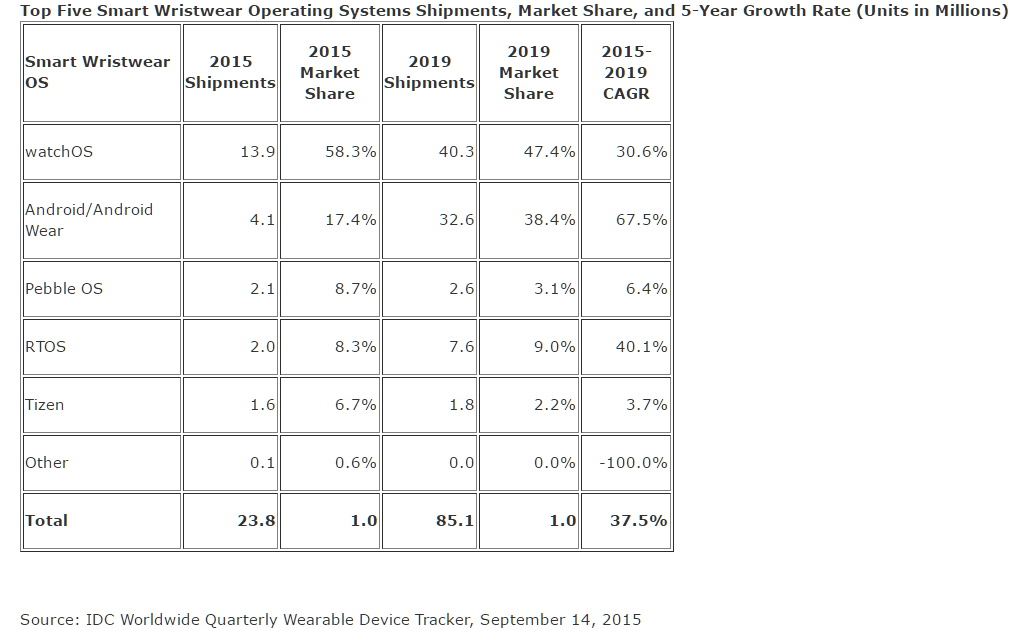Samsung sidelined Android Wear in 2015, despite the fact that some Android Wear users granted Samsung a hiatus in Google’s wearables platform and anticipated “a return to form” in 2016. In 2016, though, Samsung didn’t change course, with a Samsung executive claiming that the company would proceed with Tizen and part ways with Android Wear due to its battery efficiency and its presence on a wide range of Samsung devices such as TVs and smartphones, for example.

Perhaps this fact alone accounts for the switch, with Android Wear making very little advancement against Apple’s WatchOS. Apple continued to lead the market in Q1 2017 with 57% market share. Tizen’s 19% market share is a remarkable improvement over the 6.7% market share the platform owned 2 years ago before Samsung’s bold but smart move.

On the hardware front, Samsung has provided what is the best smartwatch display on the market, its Super AMOLED panel, into the Gear S3, along with the ruggedness and IP68 certification that many demand in their daily smartwatch to protect it against the elements. Corning’s Gorilla Glass SR+ for scratch resistance only adds to the mix.
Samsung Pay is most relevant to Samsung’s success, with the mobile payments feature allowing users to pay from the wrist as they would on their smartphone at traditional credit card/debit card readers by way of MST (magnetic secure transmission) technology without relying on NFC-only terminals. Android Wear, in contrast, mandates NFC and only provides NFC; the same can be said for Apple’s WatchOS. Samsung has recently expanded into Switzerland, United Arab Emirates (UAE), Hong Kong, and Sweden. Samsung Pay is now available for more than 85% of the US debit card and credit card market.
Battery life has been another stunning feat for Tizen. Gear S2 and Gear S3 owners achieve 2-4 days of battery life, in contrast to Android Wear users who may be fortunate to achieve 30 hours or so. The Samsung executive who leaked Samsung’s departure from Android Wear made a point to which every Gear smartwatch owner can attest.
On the whole, this feat is incredible for Tizen, a platform that many had written off as a passing fad before this study. And, even now, industry projections through 2019, as can be seen in the second chart above, still favor Android Wear overwhelmingly. If the current rise of Tizen proves anything, it proves that analysts and their predictions aren’t always right: there is a wearables market ready to embrace a third platform, that Android Wear isn’t the only or best WatchOS alternative on the market.
If Samsung can triple its market share in two years with Tizen on high-end smartwatches, then imagine what it can do with Tizen on high-end smartphones? Android Wear enthusiasts will have to place their words carefully from here on out.
Most Popular Tech Stories
- Kelly Betting – How It Works and the Kelly Criterion Explained
- What are Pokies? – The Latest Guide to How Pokies Work in Australia
- AI industry needs annual revenues of more than the UAE’s GDP to offset costs
- Pepe Unchained Meme Token ICO Hits $2 Million – Could PEPU See a Post-Launch Surge Like PEPE?
- 4 Best Meme Coins to Buy with 100x Gains Potential – Top Picks for July 2024
Latest News
Does AI increase productivity at work? New study suggests otherwise
Artificial intelligence software reduces productivity and harms the working environment, according to a study from the freelance platform, Upwork. The findings appear to question how AI is being deployed at...

















